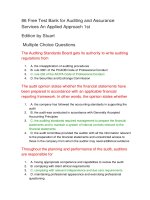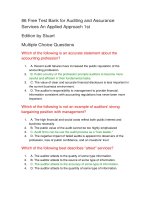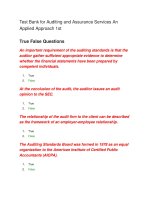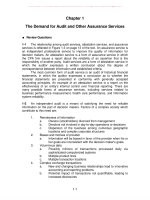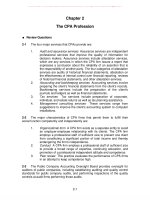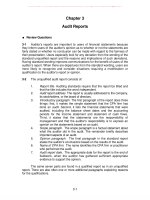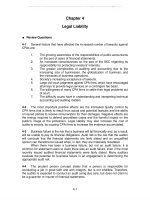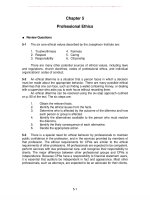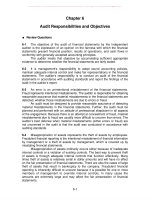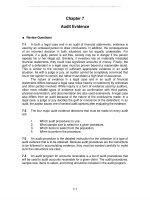Solution manual auditing and assurance services an intergrated approach 14th by arens beasley volume 2
Bạn đang xem bản rút gọn của tài liệu. Xem và tải ngay bản đầy đủ của tài liệu tại đây (2.76 MB, 284 trang )
To download more slides, ebook, solutions and test bank, visit
Instructor’s
Resource Manual
Auditing and
Assurance Services
Fourteenth Edition
Alvin A. Arens
Randal J. Elder
Mark S. Beasley
Prentice Hall
Boston Columbus Indianapolis New York San Francisco Upper Saddle River
Amsterdam Cape Town Dubai London Madrid Milan Munich Paris Montreal Toronto
Delhi Mexico City Sao Paulo Sydney Hong Kong Seoul Singapore Taipei Tokyo
To download more slides, ebook, solutions and test bank, visit
This work is protected by United States copyright laws and is provided
solely for the use of instructors in teaching their courses and assessing
student learning. Dissemination or sale of any part of this work (including
on the World Wide Web) will destroy the integrity of the work and is not
permitted. The work and materials from it should never be made available
to students except by instructors using the accompanying text in their
classes. All recipients of this work are expected to abide by these
restrictions and to honor the intended pedagogical purposes and the needs
of other instructors who rely on these materials.
VP, Editorial Director: Sally Yagan
Executive Editor: Stephanie Wall
Editorial Project Manager: Christina Rumbaugh
Production Project Manager: Carol O’Rourke
Senior Operations Specialist: Diane Peirano
Printer/Binder: Offset Paperback Manufacturers
Copyright © 2012, 2010, 2008, 2006, 2005 Pearson Education, Inc., publishing as
Prentice Hall, One Lake Street, Upper Saddle River, New Jersey 07458. All rights
reserved. Manufactured in the United States of America. This publication is protected by
Copyright, and permission should be obtained from the publisher prior to any prohibited
reproduction, storage in a retrieval system, or transmission in any form or by any means,
electronic, mechanical, photocopying, recording, or likewise. To obtain permission(s) to
use material from this work, please submit a written request to Pearson Education, Inc.,
Permissions Department, One Lake Street, Upper Saddle River, New Jersey 07458.
Many of the designations by manufacturers and seller to distinguish their products are
claimed as trademarks. Where those designations appear in this book, and the publisher
was aware of a trademark claim, the designations have been printed in initial caps or all
caps.
10 9
8
7
6
5
4
3
2
1
ISBN-13: 978-0-13-257611-6
ISBN-10:
0-13-257611-2
To download more slides, ebook, solutions and test bank, visit
CONTENTS
Page
Course Approach Suggestions ...................................................................
One-Quarter Schedule . . . . . . . . . . . . . . . . . . . . . . . . . . . . . . . . . . . . . . . . . . . . . . . . . . . . . . . . . . . . . . . . . . . . . . . . . . . . . . . . . . .
One-Semester Schedule. . . . . . . . . . . . . . . . . . . . . . . . . . . . . . . . . . . . . . . . . . . . . . . . . . . . . . . . . . . . . . . . . . . . . . . . . . . . . . . . .
One-Quarter Assignment Schedule. . . . . . . . . . . . . . . . . . . . . . . . . . . . . . . . . . . . . . . . . . . . . . . . . . . . . . . . . . . . . . . . . . . . .
One-Semester Assignment Schedule . . . . . . . . . . . . . . . . . . . . . . . . . . . . . . . . . . . . . . . . . . . . . . . . . . . . . . . . . . . . . . . . . .
Assignment of Computer-Related Problems. . . . . . . . . . . . . . . . . . . . . . . . . . . . . . . . . . . . . . . . . . . . . . . . . . . . . . . . . . .
Companion Website . . . . . . . . . . . . . . . . . . . . . . . . . . . . . . . . . . . . . . . . . . . . . . . . . . . . . . . . . . . . . . . . . . . . . . . . . . . . . . . . . . . . . .
Chapter Opening Vignettes — Lessons from Practice. . . . . . . . . . . . . . . . . . . . . . . . . . . . . . . . . . . . . . . . . . . . . . . .
Use of ACL Software . . . . . . . . . . . . . . . . . . . . . . . . . . . . . . . . . . . . . . . . . . . . . . . . . . . . . . . . . . . . . . . . . . . . . . . . . . . . . . . . . . . . .
Use of Systems Understanding Aid. . . . . . . . . . . . . . . . . . . . . . . . . . . . . . . . . . . . . . . . . . . . . . . . . . . . . . . . . . . . . . . . . . . . .
Use of Integrated Audit Practice Case . . . . . . . . . . . . . . . . . . . . . . . . . . . . . . . . . . . . . . . . . . . . . . . . . . . . . . . . . . . . . . . . .
Use of Auditing Cases. . . . . . . . . . . . . . . . . . . . . . . . . . . . . . . . . . . . . . . . . . . . . . . . . . . . . . . . . . . . . . . . . . . . . . . . . . . . . . . . . . . .
Suggested Term Projects . . . . . . . . . . . . . . . . . . . . . . . . . . . . . . . . . . . . . . . . . . . . . . . . . . . . . . . . . . . . . . . . . . . . . . . . . . . . . . . .
Summary of Additional, Changed, and Deleted Problem Material . . . . . . . . . . . . . . . . . . . . . . . . . . . . . . . . . .
v
vi
vii
viii
x
xii
xii
xiii
xiii
xiii
xiv
xiv
xiv
xxiii
CHAPTERS
I. THE AUDITING PROFESSION
1
2
3
4
5
II.
The Demand for Audit and Other Assurance Services . . . . . . . . . . . . . . . . . . . . . . . . . . . . . . . . . . . .
The CPA Profession . . . . . . . . . . . . . . . . . . . . . . . . . . . . . . . . . . . . . . . . . . . . . . . . . . . . . . . . . . . . . . . . . . . . . . . . . . .
Audit Reports. . . . . . . . . . . . . . . . . . . . . . . . . . . . . . . . . . . . . . . . . . . . . . . . . . . . . . . . . . . . . . . . . . . . . . . . . . . . . . . . . . .
Professional Ethics . . . . . . . . . . . . . . . . . . . . . . . . . . . . . . . . . . . . . . . . . . . . . . . . . . . . . . . . . . . . . . . . . . . . . . . . . . . .
Legal Liability. . . . . . . . . . . . . . . . . . . . . . . . . . . . . . . . . . . . . . . . . . . . . . . . . . . . . . . . . . . . . . . . . . . . . . . . . . . . . . . . . . .
1-1
2-1
3-1
4-1
5-1
THE AUDIT PROCESS
6
7
8
9
10
11
12
13
Audit Responsibilities and Objectives . . . . . . . . . . . . . . . . . . . . . . . . . . . . . . . . . . . . . . . . . . . . . . . . . . . . . . .
Audit Evidence . . . . . . . . . . . . . . . . . . . . . . . . . . . . . . . . . . . . . . . . . . . . . . . . . . . . . . . . . . . . . . . . . . . . . . . . . . . . . . . . .
Audit Planning and Analytical Procedures . . . . . . . . . . . . . . . . . . . . . . . . . . . . . . . . . . . . . . . . . . . . . . . . . .
Materiality and Risk. . . . . . . . . . . . . . . . . . . . . . . . . . . . . . . . . . . . . . . . . . . . . . . . . . . . . . . . . . . . . . . . . . . . . . . . . . . .
Section 404 Audits of Internal Control and Control Risk. . . . . . . . . . . . . . . . . . . . . . . . . . . . . . . . . . .
Fraud Auditing. . . . . . . . . . . . . . . . . . . . . . . . . . . . . . . . . . . . . . . . . . . . . . . . . . . . . . . . . . . . . . . . . . . . . . . . . . . . . . . . . .
The Impact of Information Technology on the Audit Process . . . . . . . . . . . . . . . . . . . . . . . . . . . . .
Overall Audit Plan and Audit Program . . . . . . . . . . . . . . . . . . . . . . . . . . . . . . . . . . . . . . . . . . . . . . . . . . . . . . .
6-1
7-1
8-1
9-1
10-1
11-1
12-1
13-1
III. APPLICATION OF THE AUDIT PROCESS TO THE SALES AND COLLECTION CYCLE
14
15
16
17
Audit of the Sales and Collection Cycle: Tests of Controls
and Substantive Tests of Transactions . . . . . . . . . . . . . . . . . . . . . . . . . . . . . . . . . . . . . . . . . . . . . . . . . . . . . .
Auditing Sampling for Tests of Controls and Substantive Tests of Transactions . . . . . . .
Completing the Tests in the Sales and Collection Cycle: Accounts Receivable . . . . . . .
Audit Sampling for Tests of Details of Balances. . . . . . . . . . . . . . . . . . . . . . . . . . . . . . . . . . . . . . . . . . . .
14-1
15-1
16-1
17-1
IV. APPLICATION OF THE AUDIT PROCESS TO OTHER CYCLES
18
19
20
21
22
23
V.
Audit of the Acquisition and Payment Cycle: Tests of Controls,
Substantive Tests of Transactions, and Accounts Payable . . . . . . . . . . . . . . . . . . . . . . . . . . . . . . .
Completing the Tests in the Acquisition and Payment Cycle:
Verification of Selected Accounts . . . . . . . . . . . . . . . . . . . . . . . . . . . . . . . . . . . . . . . . . . . . . . . . . . . . . . . . . . . .
Audit of the Payroll and Personnel Cycle . . . . . . . . . . . . . . . . . . . . . . . . . . . . . . . . . . . . . . . . . . . . . . . . . . .
Audit of the Inventory and Warehousing Cycle . . . . . . . . . . . . . . . . . . . . . . . . . . . . . . . . . . . . . . . . . . . . .
Audit of the Capital Acquisition and Repayment Cycle . . . . . . . . . . . . . . . . . . . . . . . . . . . . . . . . . . . .
Audit of Cash Balances . . . . . . . . . . . . . . . . . . . . . . . . . . . . . . . . . . . . . . . . . . . . . . . . . . . . . . . . . . . . . . . . . . . . . . .
18-1
19-1
20-1
21-1
22-1
23-1
COMPLETING THE AUDIT
24
Completing the Audit . . . . . . . . . . . . . . . . . . . . . . . . . . . . . . . . . . . . . . . . . . . . . . . . . . . . . . . . . . . . . . . . . . . . . . . . . .
24-1
VI. OTHER ASSURANCE AND NONASSURANCE SERVICES
25
26
Other Assurance Services . . . . . . . . . . . . . . . . . . . . . . . . . . . . . . . . . . . . . . . . . . . . . . . . . . . . . . . . . . . . . . . . . . . .
Internal and Governmental Financial Auditing and Operational Auditing . . . . . . . . . . . . . . . .
iii
25-1
26-1
To download more slides, ebook, solutions and test bank, visit
To download more slides, ebook, solutions and test bank, visit
Course Approach Suggestions
The purpose of the Instructor's Resource Manual is to help you teach auditing
and other assurance services courses more efficiently. Naturally, we do not want
to interfere with your present approach or imply that our suggestions are the only
good alternatives.
This resource manual has several parts:
Illustrative schedules for one-quarter and one-semester courses.
Term projects we have successfully used.
Chapter-by-chapter suggestions for teaching the content in each chapter.
The suggestions for each chapter include the following:
Ideas we find useful in teaching introductory auditing.
Homework problems we use most often.
A matrix illustrating how learning objectives correlate with chapter problem
material. The matrix for each chapter is designed to provide a one-page
summary of this information in order to assist you in assigning problem
material.
Transparency masters containing ideas we like to emphasize in class.
These are labeled with a "T" in the teaching notes for each chapter. The
transparency masters are located in the back of this book and can also be
downloaded from the Companion Website (www.pearsonhighered.com/arens).
Note that the Electronic Art Log on the Companion Website contains every table,
graph, and piece of art from the textbook. You can use the items in the art log to create
PowerPoint presentations or overhead transparencies of key figures, tables, and
other art from the textbook.
The chapters are designed so that their arrangement and selection provides
maximum flexibility in course design.
Suggested Syllabi
In this section, we provide a possible schedule for use in a one-quarter course
and in a one-semester course. We also provide suggested problem assignments that
could easily be presented in your syllabus.
Following these sample syllabi, we briefly overview other teaching materials
that you might find helpful as you develop your plan for coverage of the course content.
v
To download more slides, ebook, solutions and test bank, visit
One-Quarter Schedule (assumes two seventy-five minute sessions per week)
WEEK
NO.
CONTENTS
CORRESPONDING
CHAPTER IN TEXT
Introduction
The demand for audit and other assurance
services
The CPA profession and global standards-setting
Overview of reporting
Chapter 1
Chapter 2
Chapter 3
2
Audit responsibilities and objectives
Audit evidence
Chapter 6
Chapter 7
3
Audit planning and analytical procedures
Materiality and risk
Chapter 8
Chapter 9
4
Sec. 404 audits of internal control and control risk
Fraud auditing
Chapter 10
Chapter 11
5
The impact of information technology on the audit
process
Midterm examination
Chapter 12
Midterm
1
6
7
8
Overall audit plan and audit program
Audit of the sales and collection cycle: tests of
controls and substantive tests of transactions
Chapter 13
Accounts receivable: tests of details of balances
Audit sampling for tests of controls and
substantive tests of transactions
Chapter 16
Chapter 14
Chapter 15
Audit sampling for tests of controls and
substantive tests of transactions (cont.)
Completing the audit
Chapter 15
Chapter 24
9
Audit reporting—other assurance reports
Professional ethics
Chapter 25
Chapter 4
10
Legal liability
Internal and governmental financial auditing and
operational auditing
Chapter 5
vi
Chapter 26
To download more slides, ebook, solutions and test bank, visit
One-Semester Schedule (assumes two seventy-five minute sessions per week)
WEEK
NO.
CONTENTS
CORRESPONDING
CHAPTER IN TEXT
Introduction
The demand for audit and other assurance
services
The CPA profession and global standards-setting
Overview of reporting
Chapter 1
Chapter 2
Chapter 3
2
Professional ethics
Legal liability
Chapter 4
Chapter 5
3
Audit responsibilities and objectives
Audit evidence
Chapter 6
Chapter 7
4
Audit planning and analytical procedures
Materiality and risk
Chapter 8
Chapter 9
5
Materiality and risk (cont.)
Midterm examination #1
Chapter 9
Midterm #1
6
Sec. 404 audits of internal control and control risk
Fraud auditing
Chapter 10
Chapter 11
7
The impact of information technology on the audit
process
Overall audit plan and audit program
Chapter 12
Chapter 13
Audit of the sales and collection cycle: tests of
controls and substantive tests of transactions
Accounts receivable: tests of details of balances
Chapter 14
Chapter 16
Audit sampling for tests of controls and
substantive tests of transactions
Audit sampling for tests of details of balances
Chapter 15
Chapter 17
Audit sampling for tests of details of
balances (cont.)
Midterm examination #2
Chapter 17
Midterm #2
1
8
9
10
11
Audit of the acquisition and payment cycle
Chapter 18
Chapter 19
12
Audit of cash balances
Completing the audit
Chapter 23
Chapter 24
13
Audit reporting-completion and other assurance
services reports
Chapter 3
Chapter 25
14
Internal and governmental financial auditing and
operational auditing
Chapter 26
vii
To download more slides, ebook, solutions and test bank, visit
One-Quarter Assignment Schedule
SESSION
READING
ASSIGNMENT
(CHAPTER)
SUBJECT
PROBLEM
ASSIGNMENT
1 and 2
1-17, 1-18, 2-22,
Internet 2-1
Overview of reporting
3
3-29, 3-30, 3-33
3
Audit responsibilities and objectives
6
6-22, 6-24, 6-27,
6-30
4
Audit evidence
7
7-27, 7-28, 7-33,
7-40
5
Audit planning and analytical
procedures
8
8-26, 8-32, 8-37,
8-39, 8-40, 8-41
6
Materiality and risk
9
9-25, 9-31, 9-34,
9-26, 9-36, 9-37
7
Sec. 404 audits of Internal control
and control risk
10
10-36, 10-40, 10-43
8
Fraud auditing
11
11-23, 11-24, 11-28,
11-34
9
The impact of information
technology on the audit process
12
12-21, 12-24, 12-29,
12-30, 12-31
1
Introduction, audit and assurance
services, and the CPA profession
2
10
Midterm
Midterm
11
Overall audit plan and audit
program
13
13-26, 13-30, 13-31,
13-32, 13-36
12
Audit of the sales and collection
cycle: tests of controls and
substantive tests of transactions
14
14-25, 14-32, 14-34,
14-35
13
Accounts receivable: tests of details
of balances
16
16-23, 16-26, 16-27,
16-29, 16-35, 16-36
14
Audit sampling for tests of controls
and substantive tests of
transactions
15
15-28, 15-29, 15-34
15
Audit sampling for tests of controls
and substantive tests of
transactions (cont.)
15
15-35
16
Completing the audit
24
24-27, 24-28, 24-33
17
Audit reporting-completion
25
25-25, 25-26, 25-28
18
Professional ethics
4
4-21, 4-25, 4-26,
4-28
19
Legal liability
5
5-20, 5-24, 5-28
20
Internal and governmental financial
auditing and operational auditing
26
26-23, 26-26
viii
To download more slides, ebook, solutions and test bank, visit
One-Semester Assignment Schedule
SESSION
READING
ASSIGNMENT
(CHAPTER)
SUBJECT
PROBLEM
ASSIGNMENT
1 and 2
1-17, 1-18, 2-22,
Internet 2-1
Overview of reporting
3
3-29, 3-30, 3-33
3
Professional ethics
4
4-21, 4-25, 4-26,
4-28
4
Legal liability
5
5-20, 5-24, 5-28
5
Audit responsibilities and objectives
6
6-22, 6-24, 6-27,
6-30
6
Audit evidence
7
7-27, 7-28, 7-33,
7-40
7
Audit planning and analytical
procedures
8
8-26, 8-32, 8-37,
8-39, 8-40, 8-41
8
Materiality and risk
9
9-25, 9-31, 9-34
9
Materiality and risk (cont.)
9
9-26, 9-36, 9-37
10
Midterm #1
11
Sec. 404 audits of internal control
and control risk
10
10-36, 10-40, 10-43
12
Fraud auditing
11
11-23, 11-24, 11-28,
11-34
13
The impact of information technology
on the audit process
12
12-21, 12-24, 12-29,
12-30, 12-31
14
Overall audit plan and audit program
13
13-26, 13-30, 13-31,
13-32, 13-36
15
Audit of the sales and collection
cycle: tests of controls and
substantive tests of transactions
14
14-25, 14-32, 14-34,
14-35
16
Accounts receivable: tests of details
of balances
16
16-23, 16-26, 16-27,
16-29, 16-35, 16-36
17
Audit sampling for tests of controls
and substantive tests of transactions
15
15-28, 15-29, 15-34,
15-35
18
Audit sampling for tests of details of
balances
17
17-28, 17-29, 17-30
19
Audit sampling for tests of details of
balances (cont.)
17
17-31, 17-33
20
Midterm #2
1
Introduction, audit and assurance
services, and the CPA profession
2
Midterm #1
Midterm #2
ix
To download more slides, ebook, solutions and test bank, visit
One-Semester Assignment Schedule (continued)
READING
ASSIGNMENT
(CHAPTER)
PROBLEM
ASSIGNMENT
SESSION
SUBJECT
21
Audit of the acquisition and payment
cycle: tests of controls, substantive
tests of transactions and accounts
payable
18
18-23, 18-25, 18-30,
18-32
22
Completing the tests in the
acquisition and payment cycle:
verification of selected accounts
19
19-21, 19-23, 19-28,
19-30
23
Audit of cash balances
23
23-18, 23-21, 23-25
24
Completing the audit
24
24-27, 24-28, 24-33
25*
Overview of reporting (continued)
3
26
Audit reporting—completion
25
25-25, 25-26, 25-28
27
Internal and governmental financial
auditing and operational auditing
26
26-23, 26-26
28
Internal and governmental financial
auditing and operational auditing
(cont.)
26
26-27
*Can be used as a catch-up session or as a review of audit reporting before covering Chapter 25 in
the next session.
Chapter Opening Vignettes – Lessons from Practice
Each chapter begins with a short vignette that is based on a realistic situation
that auditors might expect to face in practice. In addition, each chapter contains several
mid-chapter vignettes that highlight other real-world issues that relate to the chapter
content, including recent events, news articles, fraud cases, or related thought
papers and articles. Many of these opening and mid-chapter vignettes summarize
actual company issues, while others highlight realistic judgments faced by auditors in
practice.
We have used these vignettes in our own classrooms over the years. We have
also shared them with others. One of our colleagues has used them as a "Lesson for
the Day" for students. Each vignette illustrates the point implied by its title. Thus, they
can be used by the instructor as pre-reading for discussion of a particular point or as
short cases on a stand-alone basis. In any event, we believe they are interesting and
add a flavor that does not otherwise exist in the traditional academic study of
auditing, unless significant time is spent on longer case studies.
We suggest you review all 26 opening vignettes plus the shaded mid-chapter
vignettes at the beginning of the course and decide which ones to use and how they
can be used in your auditing class. A brief discussion of many of the vignettes appears
in each chapter’s material in this resource guide. Several of them emphasize
international issues.
x
To download more slides, ebook, solutions and test bank, visit
End of Chapter Cases and Internet Problems
Internet-based case/homework assignments are included in the end of chapter
material for each of the 26 chapters. These assignments require students to use the
Internet to research relevant auditing issues and they expose students to real-world
events, such as actual SEC enforcement actions related to a fraud investigations,
actual audit committee charters that outline the audit committee’s role in the
oversight of the external auditor selection process, and management reports on
internal control filed with the SEC. We believe these assignments provide opportunities
for students to engage in research activities outside traditional homework problems to
learn about issues affecting the audit process. Some of these can be assigned
as individual assignments while others could be assigned to groups for in-class
presentation and discussion.
In addition to the Internet Problems, most chapters include Cases that challenge
students beyond what is required in other end of chapter problems. They are
generally more complex than other homework problems. Thus, we sometimes assign
these as group assignments that can be worked outside of class or we assign them
as in-class assignments whereby students work together to develop a group solution
to the case for subsequent class discussion.
Pinnacle Manufacturing Integrated Case
For instructors who are interested in providing a more complex case that students
can work across multiple chapters, we have included the Pinnacle Manufacturing
Integrated Case. This seven-part case has been revised and expanded to give
students a hands-on experience that begins in Chapter 8 and concludes in Chapter 16.
The case can be worked individually or in small teams.
Use of ACL Software
Students receive a full working version of ACL Software with the textbook.
Students use this software, which includes several hypothetical databases, to
complete several ACL-based homework problems in selected chapters. The problems
that use ACL software are 7-40, 8-41, 11-35, 12-31, 14-35, 16-36, and 17-38. These
problems are designated by the ACL logo in the margin next to the problem.
Instructors who want to provide more detailed coverage of ACL software can
use Computerized Auditing Using ACL, Second Edition (2008) by Alvin A. Arens.
This resource is designed for use as a supplement in either an undergraduate or
advanced auditi ng course and contains Version 9.0 software, along with data sets
for eight companies. Students work through this 25-35 hour project outside of class
time, but the project also provides great flexibility for you to cover important concepts
in class. After completing Computerized Auditing Using ACL, students will have an indepth understanding of how audit software is used in practice for both data analysis
and audit testing.
xi
To download more slides, ebook, solutions and test bank, visit
Assignment of Computer-Related Problems in the Textbook
In the chapter problem materials, there are problems that can be solved using
Excel. You may assign these problems to be done manually, with the computer, or
both, at your discretion. In the solutions manual, we offer solutions on both bases. In
addition, we offer the solution templates and relevant data files on the Companion
Website.
The list below notes the problems that can be assigned for solving with computer
assistance through the use of Excel software, along with the related file names on the
Website.
PROBLEM
EXCEL
NUMBER
FILE NAME
7-37
8-39
8-40
9-36
P737.xls
P839.xls
P840.xls
P936a.xls
P936b.xls
P1043a.xls
P1043b.xls
P1434a.xls
P1434b.xls
P1525.xls
P1526.xls
P1535.xls
P1635.xls
P1730.xls
P1734.xls
P1736.xls
P1737.xls
P1832.xls
P2129.xls
P2133.xls
10-43
14-34
15-25
15-26
15-35
16-35
17-30
17-34
17-3617-37
18-32
21-29
21-33
The files listed above are available on the Companion Website.
Companion Website
The Arens/Elder/Beasley Companion Website (www.pearsonhighered.com/arens)
includes a wide variety of resources, including current event articles, relevant Internet
links for each chapter, Internet-based case/homework assignments for every chapter,
and free online quizzes for students.If needed, periodic updates of major professional
developments may be posted on the Companion Website for instructor downloading
and review.
xii
To download more slides, ebook, solutions and test bank, visit
Other Resources That We Use
In addition to the many features included in this 14th edition of Auditing and
Assurance Services: An Integrated Approach, there are several other resources that
we find useful as complimentary materials and assignments. These are briefly
highlighted next.
Use of Systems Understanding Aid
We find the use of the publication, Systems Understanding Aid, Alvin A. Arens
and D. Dewey Ward, Armond Dalton Publishers, Inc., (2008) to be extremely useful.
The aid is a self-study document that has students work through a simple accounting
system, including application of internal controls. It is typically assigned to be done
outside of class during the first four weeks, prior to the study of internal control. The
aid will give students an adequate familiarity with documents and records to increase
their understanding of internal control.
Use of Integrated Audit Practice Case
The Integrated Audit Practice Case, David S. Kerr, Randal J. Elder, and Alvin A.
Arens, Armond Dalton Publishers, Inc., (2011) can be used to give students handson experience making audit judgments and completing audit documentation. The
case can be completed individually or in groups, and includes 10 assignments that
can be assigned throughout the semester. The assignments take students through the
planning phase, evaluation of internal control and performance of tests of transactions,
substantive tests of balances, and completing the audit. The case includes a CD that
allows students to complete selected assignments in Excel.
Use of Auditing Cases
Auditing Cases: An Interactive Learning Approach, Fourth Edition (2011) by
Beasley, Buckless, Glover, and Prawitt is an excellent supplement to the textbook.
This collection of over 40 auditing cases addresses most major activities performed
during the conduct of an audit, from client acceptance to issuance of an audit report.
Many of the cases are based on actual companies, some of which were engaged in
financial reporting fraud. Several cases involve students working with realistic audit
evidence and preparing and evaluating audit documentation Auditing Cases: An
Interactive Learning Approach provides instructors an easy opportunity to introduce
short active learning exercises to promote in-class discussions of real-world audit
issues throughout the introductory auditing course.
Suggested Term Projects
1.
Have students obtain a public company’s recent Form 10-K filing with the SEC
and, using a team approach, prepare an analysis of business risks affecting
the financial reporting process and develop an audit plan (overview level)
for the company selected.
xiii
To download more slides, ebook, solutions and test bank, visit
2.
3.
Have students go through the audit process for the acquisition and payment
cycle of a small manufacturing company from flowcharting the system to
designing the audit program.
Have students evaluate the sampling approach used by an auditor for sales
and cash receipts for a small business. The case can be used conveniently
with nonstatistical sampling, difference estimation, or monetary unit sampling.
The requirements should be modified depending on the alternative you
select.
Syllabus excerpts for each project follow.
xiv
To download more slides, ebook, solutions and test bank, visit
TERM PROJECT 1
Analysis and Audit Plan
The objectives of this project are as follows:
1.
2.
3.
To acquaint students with the Form 10-K of a publicly held company audited
by a CPA firm.
To provide data for the practical application of certain steps in the audit
process.
To allow students to experience working in teams, as is done in actual
auditing.
Detailed Instructions
1.
2.
Form a group of four persons. Discuss how you will organize (assign
responsibilities) to complete this project in a suitable format.
Visit the SEC’s website (www.sec.gov) to obtain a copy of a recent Form
10-K filing by a publicly held company with stock actively traded on the New
York, NASDAQ or other over-the-counter exchanges. Answer the following
questions:
a.
b.
c.
d.
e.
f.
g.
3.
What is the company's industry?
What are its primary products?
What raw materials does the company use?
How large is the company:
sales
assets
employees
Where is the company located?
What other people/companies are closely associated with this company?
Look at the Form 10-K:
What information is included in Item 1 and Item 1A of the Form 10-K?
How might that information be useful to the audit during audit
planning?
Obtain outside information about the company and its industry. Answer the
following questions:
a.
b.
c.
d.
e.
What are the key economic factors about the industry?
Where is the company in its life cycle?
What are the five or six most important factors for success in this
business?
How does this company stand with respect to these factors?
Describe four or five key business risks related to the client’s business
and industry.
xv
To download more slides, ebook, solutions and test bank, visit
f.
g.
h.
4.
Analyze the company's financial strength:
a.
b.
c.
d.
e.
f.
5.
Assess the financial strength of the company?
How is the financial strength likely to change in the next year or so?
What are its sources of capital and what is the value of the company's
capital?
How have capital markets responded to the company in the last year?
What is the quality of earnings?
How does the company compare with others in the industry?
Prepare a broad audit plan:
a.
b.
c.
d.
e.
f.
g.
6.
What notable accounting considerations are there for companies in this
industry?
What legal or regulatory matters are of concern?
What social matters are of concern?
What material types of transactions and transaction cycles are involved?
What are the high-risk areas?
What are the low-risk areas?
If management faced tremendous pressure regarding the entity’s
financial performance, what opportunities might exist for them to engage
in fraudulent financial reporting?
To what extent do you believe it will be appropriate to reduce assessed
control risk?
How will audit effort be allocated among geographical areas?
What form of auditors' report do you expect will be issued; what does it
mean?
Indicate as an appendix to the report how the project team was organized
and how it functioned on the project.
The project will be graded as follows:
ITEM
2-4
5
6
CONTENT
40%
30%
10%
80%
STYLE
TOTAL
20%
20%
100%
This project accomplishes several purposes. First, it relates the course content
to a real (although broadly presented) situation. The students get the idea of auditing
the business, not just the books. Students are confronted — some for the first time —
with having to obtain, study, and understand content in a Form 10-K. They have to
think about such things as business risk and allocation of scarce resources as a
decision maker.
xvi
To download more slides, ebook, solutions and test bank, visit
Having the project done by teams is an important part of the approach. Audits
are done by teams and auditors must learn to operate successfully in this mode. The
team's report determines the grade for each member of the team, regardless of how
the team allocated effort. In grading the report, 20 percent of the grade is based on
communication quality. This includes organization, style, grammar, neatness, etc.
Since effective communication is so essential in practice, this skill receives emphasis
in many ways throughout the course.
Schedule for Completing Term Project:
Week 1
–
Form group.
Week 2
–
Hold organizational meeting.
Week 3
–
Obtain and the 10-K report.
Week 10 –
Complete and hand in project.
xvii
To download more slides, ebook, solutions and test bank, visit
TERM PROJECT 2
Internal Control and Audit Program Case
You are provided with the following description of the accounting system and internal
controls for materials purchases by the Johnson Machinery Company, a mediumsized firm that builds special machinery to order.
Materials purchase requisitions are first approved by the plant foreman, who
then sends them to the purchasing department. Purchasing department employees
enter the purchase requisition information into the computer, which automatically
generates a purchase order in sequential order. The system automatically generates
a paper copy of the purchase order, which is sent by purchasing department employees
to the vendor. The receiving department electronically accesses a copy of the purchase
order, which is printed to serve as a receiving report.
Delivered materials are immediately sent to the storeroom. The completed
receiving report, which is a printed copy of the purchase order, is sent to the purchasing
department. A copy of the receiving report is sent to the storeroom. Materials are
issued to factory employees subsequent to the verbal request by one of the foremen.
When the mailroom clerk receives vendors' invoices, he or she forwards them
to the purchasing department employee who placed the order. The invoice is compared
with the electronic copy of the purchase order for price and terms by the employee.
The invoice quantity is compared with the receiving department's report. After checking
footings, extensions, and discounts on the vendor invoice, the employee indicates
approval for payment by initialing the invoice. The invoice is then forwarded to the
accounting department (voucher section) where it is coded for account distribution,
assigned a voucher number, and entered into the accounting system for recording in
the voucher register. The system tracks invoices due by payment date due. The
purchase order and receiving report are filed in the purchasing department.
On payment dates, the system automatically generates a request for payment.
The system automatically prepares checks and a transaction list for preparation of a
cash disbursements journal, updates the accounts payable master file, and indicates
the payment date for the voucher register. Prenumbered checks are sent to the
cashier, who puts them through the check-signing machine. The checks are then
sent to the voucher section that makes sure that the checks were correctly prepared.
The checks are placed in envelopes and sent to the mailroom. The vouchers are
subsequently filed in numerical order. At the end of each month, a computer listing of
voucher and cash disbursement transactions, and an outstanding accounts payable
list is prepared.
xviii
To download more slides, ebook, solutions and test bank, visit
Required:
1.
2.
3.
4.
5.
6.
7.
Prepare a flowchart for the acquisition and the payment cycle for Johnson
Machinery Company.
List the controls in existence for each of the six transaction-related audit
objectives for acquisitions.
For each control in part 2, list one test of control procedure for verifying its
effectiveness.
List the most important deficiencies in the acquisition and payment cycle.
Identify the most likely error or fraud that could result from each of the
deficiencies listed in part 4.
Suggest a system alteration for JMC that would correct each of the
deficiencies identified in part 4. Be sure to keep cost/benefit in mind.
Design an audit program to test internal control. The program should
include, but not be limited to, tests of controls from part 3 and procedures to
compensate for the deficiencies in part 4.
xix
To download more slides, ebook, solutions and test bank, visit
TERM PROJECT 3
Audit Sampling Case
Hip E. Dude, CPA, is doing the audit of Baggum Gun and Rack Shop, a national
wholesaler of rifles and related equipment and supplies. He is surprised at the results
found so far in the testing of sales and sales returns. There are large numbers of
misstatements in the sales tests, which were done using a nonstatistical sample.
There are a variety of misstatements, including pricing, extensions, footings,
failure to record, and duplicate recording in sales returns and postings to the
accounts receivable master file. The confirmation of accounts receivable also indicates
numerous misstatements. Upon analysis of the misstatements, he concludes that the
problem is extremely sloppy accounting, rather than intentional misstatements.
When Dude informs management of the problem, he is told that they are not too
surprised. Customers have been complaining about their bills in recent months, and
the company accountant has been having personal problems. He has now been
discharged, and the company is in the process of hiring a new accountant. The owner
states that she does not feel that the problem is serious from a financial statement
point of view, because the misstatements mostly offset each other.
Dude is not convinced that the problem of overall financial statement misstatements
is as minor as the owner states. He decides that additional confirmation of accounts
receivable is required under the circumstances. Further thought leads him to conclude
that there are two problems: the positive confirmation response has been only
approximately 25% to 30% in the past, and it is now 45 days after the balance sheet
date. After considerable deliberation, Dude decides to select a combined sample of
sales and sales returns and determine the effect of the misstatements on net sales
and earnings. He has concluded that a misposting of a sale or return to the wrong
customer is not a misstatement, because gross sales are correctly stated. The owner
assures Dude that failure to bill a customer even for a period of several months is not
likely to make the receivable uncollectible.
Total recorded sales amount to $15,356,686 and recorded sales returns are
$1,492,797. Dude concludes that a misstatement of $210,000 affecting net earnings
would be material. He decides to use an ARIA of 10% and an ARIR of 25%. He has
no basis for estimating the standard deviation or a point estimate. He decides to
randomly select 100 items to calculate these two items.
The sales invoices for the year started with 15,424 and ended with 28,841. They
are recorded in the sales journal in the order of issue rather than sequentially. Sales
returns and allowances, which are sequentially recorded in the sales returns and
allowances journal, start with 1351 and end with 4,301.
Based upon the sample size of 100 items, of which 26 were sales returns and
allowances, the following misstatement information was noted. The value of the 67
items in the sample that have no misstatements is $77,280.
xx
To download more slides, ebook, solutions and test bank, visit
TYPE OF MISSTATEMENT
RECORDED
VALUE
AUDIT
VALUE
SALES:
Pricing
$
98.50
333.00
25.30
1,147.40
789.10
615.00
542.25
2,040.40
998.00
478.50
13.12
883.20
629.50
174.39
$
95.50
310.00
25.10
1,117.04
758.90
605.00
539.25
2,000.00
948.00
432.50
131.20
890.20
653.40
194.39
Extensions and footings
921.00
292.80
448.50
168.20
1,515.15
2,750.50
7,137.00
111.10
727.20
10.00
901.00
278.50
430.50
155.00
1,499.00
2,570.50
7,173.00
125.10
772.20
100.00
(510.00)
(890.90)
(152.00)
(810.00)
(590.90)
(1.52)
-0-0-0-0-0-0-
(725.00)
(700.00)
(515.00)
(1,219.50)
(353.00)
(777.00)
SALES RETURNS:
Posting to accounts receivable master file
Failure to record sales returns
xxi
To download more slides, ebook, solutions and test bank, visit
Required:
1.
2.
3.
4.
5.
6.
7.
8.
Evaluate the reasonableness of the sampling approach Dude is taking.
Explain how he should select the random numbers using computer generation
of random numbers.
Calculate the confidence limits for the population of sales and sales returns
combined using difference estimation. Show all intermediate steps.
Evaluate the sufficiency of the sample size Dude used in establishing the
confidence limits. How large would the sample need to be to meet Dude's
confidence limit requirements?
At what level of ARIA would Dude be able to accept the recorded value of "net
sales" as being fairly stated within acceptable materiality? Show justification
for your answer.
What would the confidence limits be for the sales population alone? Why is the
difference between your answers in 3 and 6 so large?
Suggest a strategy for Dude to follow at this point.
Be sure that the documentation of your answers is adequate for inclusion in
the audit files.
xxii
To download more slides, ebook, solutions and test bank, visit
Summary of Additional, Changed, and Deleted Problem Material
We have added new end-of-chapter homework problems and revised others in this 14th
edition of Auditing and Assurance Services: An Integrated Approach. If you have previously
used the 13th edition of our book, you may want to visit the Companion Website for our
book to see a list of new, revised, or deleted homework problems in the 14th edition
relative to problems you may have used in the 13th edition.
Question/Problem/
Case # in 13/e
CHAPTER 1
Question/Problem/
Case # in 14/e
Comments
1-14 d
1-14d
Replaced for 14/e
1-17
1-17
Modified for 14/e
1-19
1-19
Modified for 14/e
1-22
1-22
Replaced for 14/e
Internet Problem 1-1
Internet Problem 1-1
Replaced for 14/e
2-11
2-11
Modified for 14/e
2-16a
2-16a
Replaced for 14/e
2-17d
2-17d
Modified for 14/e
2-20
2-20
Modified for 14/e
2-22
2-22
Modified for 14/e
Internet Problem 2-1
Internet Problem 2-1
Modified for 14/e
CHAPTER 2
CHAPTER 3
3-20
3-21
Deleted for 14/e
3-20
3-21
New for 14/e
3-25
3-25
Modified for 14/e
3-27
3-27
Modified for 14/e (names)
3-30
3-30
Replaced for 14/e
Internet Problem 3-1
Internet Problem 3-1
Modified for 14/e
4-17
4-5
Modified and replaced for 14/e
4-5 through 4-16
4-6 through 4-17
Shifted numbers, same problems
4-22
4-22
New for 14/e
Internet Problem 4-1
Internet Problem 4-1
Replaced for 14/e
CHAPTER 4
CHAPTER 5
5-16d
5-18 through 5-23
Deleted for 14/e
5-17d
New for 14/e
5-18
New for 14/e
5-19 through 5-24
Shifted numbers, same problems
5-24
Internet Problem 5-1
Deleted for 14/e
Internet Problem 5-1
Modified for 14/e
xxiii
To download more slides, ebook, solutions and test bank, visit
Question/Problem/
Case # in 13/e
CHAPTER 6
Question/Problem/
Case # in 14/e
Comments
6-19b
6-19b
Modified for 14/e
6-21
New to 14/e
6-21
6-22
6-22
6-23
Modified for 14/e
6-24
6-24
Modified for 14/e
6-30
6-30
Modified for 14/e
6-31
New for 14/e
6-23
Deleted for 14/e
6-31
6-32
Shift number, same problem
Internet Problem 6-1
Internet Problem 6-1
Modified for 14/e
CHAPTER 7
7-5
7-6 through 7-16
Deleted for 14/e
7-5 through 7-15
Shifted numbers, same problems
7-18 through 7-33
7-16 through 7-31
Shifted numbers, same problems
7-27b
7-25b
New for 14/e
7-30
7-28
Modified for 14/e
7-31 through 7-33
7-29 through 7-31
Shifted numbers, same problems
7-32
New for 14/e
7-34 through 7-41
7-33 through 7-40
Shifted numbers, same problems
7-36
7-35
Modified for 14/e
Internet Problem 7-1
Internet Problem 7-1
Modified for 14/e
CHAPTER 8
8-25d
8-25d
Replaced for 14/e
8-29
8-29
Replaced for 14/e
8-30
8-30
Modified for 14/e
8-31
8-31
Modified for 14/e
8-32
8-32
Modified for 14/e
8-37d
New for 14/e
8-37d
8-37e
Shifted number, same problem
8-40
8-40
Modified for 14/e
Internet Problem 8-1
Internet Problem 8-1
Modified for 14/e
9-22b
9-22b
Replaced for 14/e
9-23a and b
9-23a and b
Replaced for 14/e
9-24a and 9-24b
9-24a and 9-24b
Replaced for 14/e
9-25
9-25
Modified for 14/e
9-28
9-28
Modified for 14/e
9-30
9-30
Replaced for 14/e
9-31
9-31
Modified for 14/e
7-17
Deleted for 14/e
CHAPTER 9
xxiv
To download more slides, ebook, solutions and test bank, visit
Question/Problem/
Case # in 13/e
9-32c
Question/Problem/
Case # in 14/e
9-32c
Modified for 14/e
9-34
9-34
Modified for 14/e
9-37
9-37
Modified for 14/e
Internet Problem 9-1
Internet Problem 9-1
Modified for 14/e
10-20
10-20
Replaced for 14/e
10-25
10-25
Replaced for 14/e
10-30b and 10-30c
10-30b and 10-30c
Replaced for 14/e
10-31a
10-31a
Replaced for 14/e
10-32a
10-32a
Replaced for 14/e
10-33
New for 14/e
10-34 through 10-36
Shifted numbers, same problems
Comments
CHAPTER 10
10-33 through 10-35
10-36
Deleted for 14/e
10-43
10-43
Modified for 14/e
Internet Problem 10-1
Internet Problem 10-1
Modified for 14/e
11-21a
New for 14/e
11-21a and 11-21b
11-21b and 11-21c
Shifted numbers, same problems
11-23
11-23
Modified for 14/e
11-26
11-26
Modified for 14/e
11-31
New for 14/e
11-32 and 11-33
Shifted numbers, same problems
11-34
New for 14/e
CHAPTER 11
11-31 and 11-32
11-33
11-35
Shifted number, same problem
Internet Problem 11-1
Internet Problem 11-1
Modified for 14/e
12-16
12-16
Replaced for 14/e
12-17a and 12-17b
12-17a and 12-17b
Replaced for 14/e
12-18 b and 12-18c
12-18b and 12-18c
Replaced for 14/e
12-22
12-22
Replaced for 14/e
Internet Problem 12-1
Internet Problem 12-1
Modified for 14/e
13-22b
Replaced for 14/e
13-25
New for 14/e
13-26
Shifted number, same problem
CHAPTER 12
CHAPTER 13
13-22b
13-25
13-26
13-28
Deleted for 14/e
13-28
Modified for 14/e
13-34a
New for 14/e
13-34a and 13-34b
13-34b and 13-34c
Shifted numbers, same problems
13-36a
13-36a
Modified for 14/e
Internet Problem 13-1
Internet Problem 13-1
Modified for 14/e
xxv
